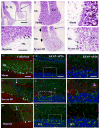Cerebellar abnormalities following hypoxia alone compared to hypoxic-ischemic forebrain injury in the developing rat brain
- PMID: 20843479
- PMCID: PMC3910430
- DOI: 10.1016/j.nbd.2010.09.001
Cerebellar abnormalities following hypoxia alone compared to hypoxic-ischemic forebrain injury in the developing rat brain
Abstract
Two-day-old (P2) rat pups were subjected to either a global hypoxia or to electrocoagulation of the right carotid artery followed by 2.5 h hypoxia. Cellular and regional injury in the cerebellum (CB) was studied at 1, 2 and 19 days using immunohistology. Following hypoxia and hypoxia-ischemia, all neuronal populations of the CB were damaged in a subset of Purkinje cells. The decrease in the number of interneurons, as well as the thickness of molecular and granular layers was significant following hypoxia. Diffuse white matter damage, with loss of preoligodendrocytes was more severe following hypoxia than hypoxia-ischemia. Global hypoxia in the rat at P2 produces extensive damage to many cell types in different areas of the CB. The addition of unilateral forebrain ischemia does not increase the severity of these changes. Our data provide insight into the mechanisms of the changes observed in the CB of premature newborns.
Copyright © 2010 Elsevier Inc. All rights reserved.
Figures







References
-
- Allin M, et al. Cognitive and motor function and the size of the cerebellum in adolescents born very pre-term. Brain. 2001;124:60–6. - PubMed
-
- Altman J, Bayer SA. Embryonic development of the rat cerebellum. III. Regional differences in the time of origin, migration, and settling of Purkinje cells. J Comp Neurol. 1985;231:42–65. - PubMed
-
- Azizi SA, et al. The pontocerebellar system in the rat: an HRP study. I. Posterior vermis. J Comp Neurol. 1981;197:543–8. - PubMed
-
- Berquin PC, et al. Cerebellum in attention-deficit hyperactivity disorder: a morphometric MRI study. Neurology. 1998;50:1087–93. - PubMed
Publication types
MeSH terms
Grants and funding
LinkOut - more resources
Full Text Sources

